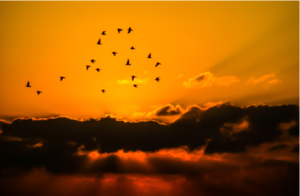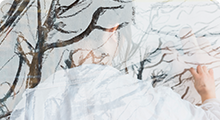Complex systems around us
Birds that flock as they fly
How are birds able to form flocks when they fly?
The English version of the Japanese saying “Like attracts like” is “Birds of a feather flock together.” Certainly, many kinds of bird do form flocks. Sometimes, when looking up at the sky, you can see birds forming flocks in a variety of patterns as they fly.

In “The Pillow Book,” her collection of essays, the Heian era poet and novelist Sei Shonagon had this to say. “In the autumn it is the sunrise. When the sinking evening sun comes close to the mountain ridge, the crows fly to their sleeping places in twos and threes, or threes and fours, striking a chord in the heart. It goes without saying that when wild geese fly in single file across the sky, looking tiny in the distance, this too is charming.” Thus she gave a precise description of the different ways crows and wild geese flock as they fly.
How can birds remain as a flock in flight while simultaneously, and moreover instantaneously, changing direction?
How do they communicate with each other? Do flocks of birds perhaps have a boss or leader?
In answer to this kind of question, the world of computer graphics provided an unexpected hint(⇒ reference to Boids model)
Many different creatures form flocks in their daily lives.
It is worth noting that the Japanese character for flock (群) incorporates the character for sheep (羊), which is itself a flocking animal.
The seas that surround Japan are patrolled by schools of fish like the sardine, Pacific saury, and bonito .
On the African Savannah, there are several kinds of mammals that create such groups, including zebras, elephants and lions.
In many cases, the individual groups of animals formed maintain their own territories, such as in the case of lions and wolves
(⇒reference to “territory”)
In wide-open spaces such as grasslands and forests, when multiple groups maintain territories, it becomes something like a segmentation phenomenon.
Reference here to “segregation /differentiation.”
There are two broad categories of group. In one type, the group itself does not move much even when the individual creatures move, and in the other type, the individual creatures move while flocking together.
The former would include a herd of sheep as they eat grass, and the latter would include a flock of wild geese during migration.
It is possible to observe these two types of group among sea fish as well.
We humans also exhibit a variety of flocking behavior, such as young people hanging out on a certain street corner.
Primary school children who somehow divide themselves into several groups while chatting in classrooms during break time.
Crowds of people who flee in panic, or attempt to escape from floods, and follow the person in front of them.
Among the many groups of creatures, it is flocks of birds that are most familiar to us and that draw our attention.
For example, many different types form a variety of flocks in flight, such as wild geese, crows, seagulls and cormorants.
What shapes do these flocks form? Why do they take this shape?
What is particularly striking is the way that the entire flock suddenly, and almost simultaneously, changes direction. It is almost as if they are performing mass games.
How do they synchronize with each other? Where is the individual (leader) that gives the instructions?
By what method does the leader convey its instructions to the other members of the flock?
In the past it was thought that birds must have some kind of extra-sensory perception (ESP), and experiments designed to detect these supernatural abilities continued for many years,
but no research succeeded in finding them. (Furthermore, it seems that migratory birds are equipped with a sensor that perceives the Earth's magnetic field.)
However, in recent years we have come to understand that the hypothesis was erroneous from the start.
Even without hypothesizing any special ability, we now know that birds are able to form and fly in the flocks that we observe every day.
For example, migratory flocks such as those formed by wild geese create lift (upward force) for birds following behind, which apparently enables them to fly without consuming much energy. This force does not act on the leading bird, which becomes tired, but which is replaced every now and again, thus allowing the flock as a unit to fly for long distances. In this way, the shape of the flock can be explained rationally in terms of fluid dynamics.
More generally, how are the flocks that form clumps of flying birds created?
The trigger for approaching this problem came not from detailed observations of flocking birds, but from the world of computer graphics.
This took place about 30 years ago. The appearance of a flock of many flying “agents,” consisting of so-called “boids” (formed by combining “bird” with the suffix “-oid,” indicating likeness to an object), was created on a computer screen. Because this used a technique called multi-agent simulation, it was called the “Boids model.”
From that day to this, computer graphics have been used widely in a wide range of movies to create lifelike representations of crowd and collective behavior. These are truly realistic, so that those held spellbound by the screen do not even notice the difference.
The idea behind the Boids model was that it could reproduce not only flocks of birds, but also that it had the general property of being able to reproduce flocking behavior in other creatures.
(⇒reference to Boids model)



